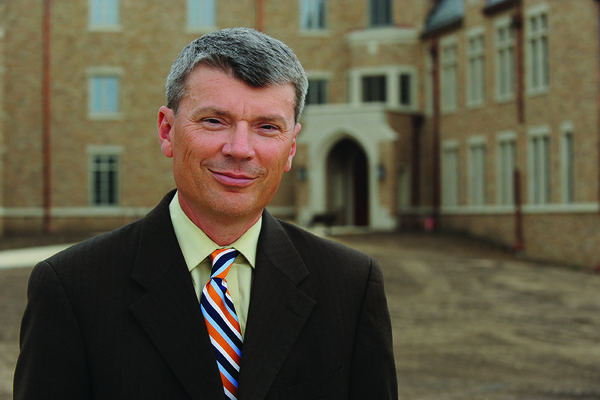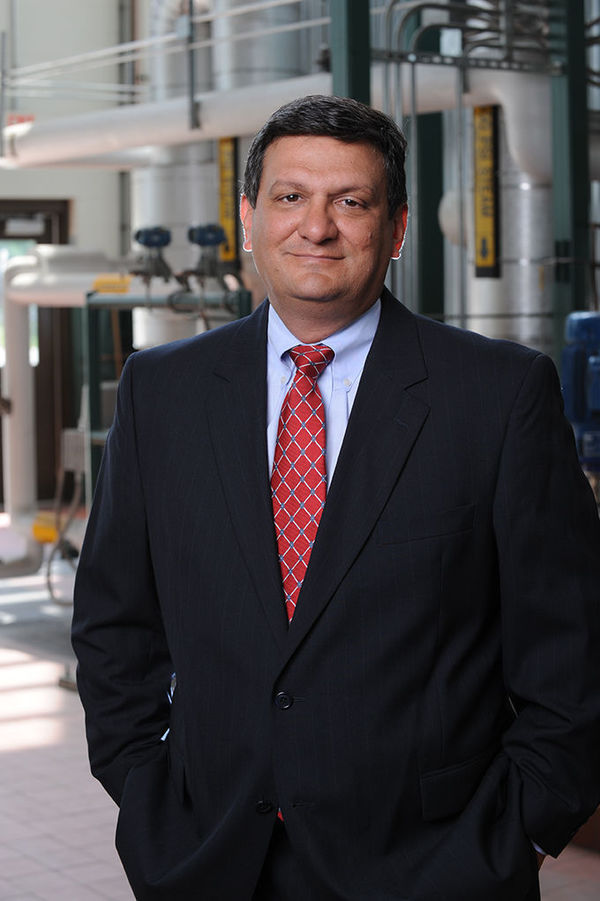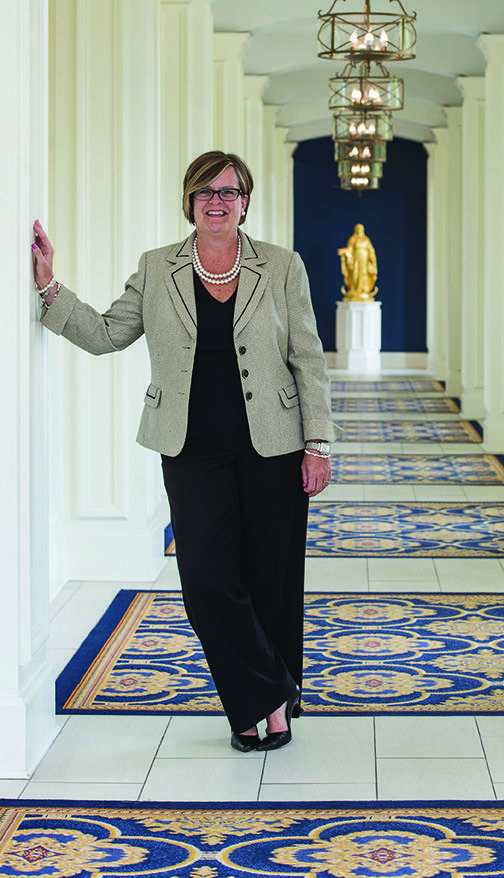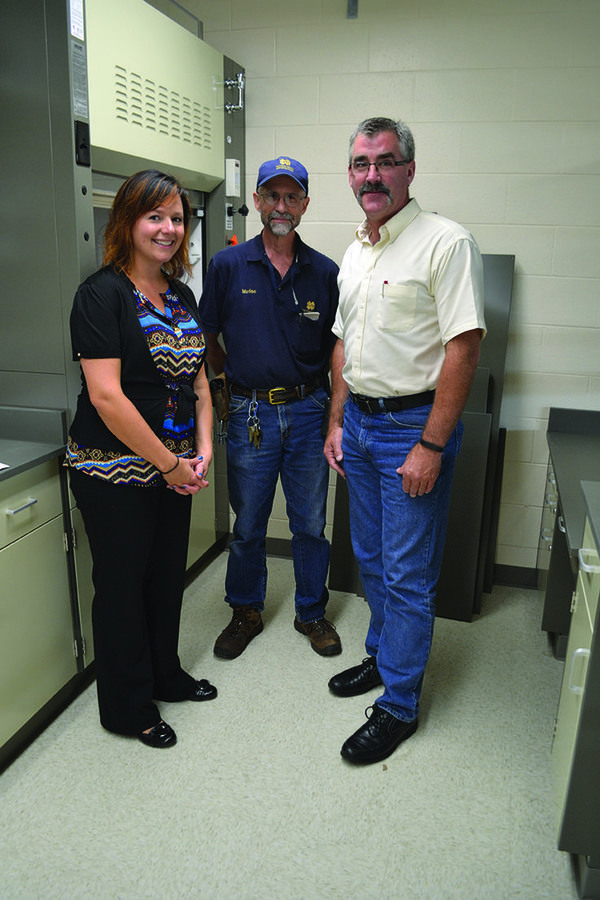Doug Marsh, University Architect
‘We are stewards of the University’
 Doug Marsh
Doug Marsh
Notre Dame’s campus is consistently ranked among the most beautiful in America—and the team that’s behind the planning, design and construction, maintenance and long-term renewal of the University’s physical plant is Facilities Design & Operations, led by Doug Marsh, associate vice president and University Architect.
Responsibilities of the division’s 125 employees are wide-ranging but can be divided into four major areas: project design and construction; interior architecture; maintenance and utilities. All these areas are committed to work together seamlessly and outside of silos that are often found among these units on other campuses.
While the current construction of new major campus facilities such as McCourtney Hall, Jenkins Hall, Nanovic Hall, two new residence halls, Corbett Family Hall, the Duncan Student Center, and the new Music/Sacred Music Building (Campus Crossroads Project) may be the most visible evidence of their work, “It would be a mistake to focus just on new construction,” says Marsh. “We have a balanced mission—we see ourselves as the chief stewards of this incomparably beautiful and historic campus.
As new buildings are constructed and older facilities renovated, the division also manages daily operations of facilities as well as the delivery of energy and water to service the buildings.
“We think of us as overseeing a ‘cradle-to-grave operation,’” says Marsh. “We’re responsible for a continuum of services beginning with the planning of the campus and ending with providing consistently reliable utilities and maintenance to all of its facilities. We are better builders and planners because we know that we will care for new buildings after they are constructed. And we are better long-term stewards because Utilities and Maintenance is at table helping to design them. This approach helps us make informed value-based design decisions with respect to long-term operational costs, sustainability and durability.”
An emphasis on sustainability is part of the division’s stewardship of the University’s resources. Nine new buildings are LEED-certified, including Geddes Hall, Ryan Hall, Purcell Pavilion, Innovation Park, Carole Sandner Hall, Stinson-Remick Hall, and the Morris Inn, all of which received LEED Gold Certification from the United States Green Building Council.
In addition, energy conservation measures the division has introduced campus-wide, such as programmable thermostats and LED lighting, have reduced electrical demand by 20 percent.
When alumni and visitors arrive on campus, they often comment on how beautiful it is, Marsh says. “And they also note how well our campus is cared for. Our goal,” he says, “is to do things the right way the first time—as we say in our mission statement—developing, maintaining and renewing environments that provide for teaching, learning, research, living and working, consistent with our heritage and responsibilities as the world’s preeminent Catholic university.”
 Paul Kempf
Paul Kempf
Paul Kempf, senior director of utilities and maintenance
People take utilities for granted, ‘and that’s the way we want it’
The Utilities Department is dedicated to providing reliable, low-cost and environmentally compliant utility services across campus.
The department is led by Paul Kempf, senior director of utilities and maintenance.
Kempf has been at Notre Dame, one way or another, for most of his life. His home address at birth was Vetville, the University’s married student housing where World War II veterans on the G.I. Bill lived with their wives and families.
Kempf’s father worked in the power plant under Brother Borromeo Malley, C.S.C., who supervised both the power plant and the fire department, and later succeeded Brother Borromeo. Kempf was appointed director of utilities in 1998, and senior director in 2011.
Utilities are something most people take for granted, Kempf says, “and that’s the way we want it.” People notice utilities mainly when something goes wrong.
The University has invested in an efficient and effective way to provide energy on campus and at the same time to be good stewards of the University’s resources, Kempf says.
Energy is produced on campus at the power plant, a building that has existed in the same location east of St. Joseph Lake since 1932 (power generation on campus dates to the late 1800s.) “It’s a combined heat and power plant, which allows us to provide energy, and use waste energy to produce heat,” says Kempf.
The production of steam can be derived from a variety of fuel sources, including coal, #2 and #6 fuel oil and natural gas. Over the past few years, the amount of coal has been reduced to 15 percent of total campus energy usage.
On September 21, President Rev. John I. Jenkins, C.S.C. announced that the University will cease burning coal entirely within five years, and cut its carbon footprint by more than half by 2030.
The power plant today houses many pieces of equipment, including six boilers, seven chillers and ten generators. The six boilers produce steam, while generators (five steam-driven turbine generators and five diesel engine-driven generators) produce electricity. Five steam-driven and two motor driven centrifugal chillers produce chilled water.
The department has 50 employees. Nineteen are plant operators, eleven handle maintenance and others provide engineering support. The distribution team maintains pipes and wires, while the controls group manages or monitors systems.
In addition to steam, the power plant produces nearly half of the electricity the University uses. Other ancillary products include compressed air and drinking water. The department also manages both storm and sanitary sewers.
Visit the website, utilities.nd.edu, for outage information, to request service or to download a brochure with additional information on the power plant as well as the University’s energy and environmental stewardship efforts.
The department is also happy to offer tours of the power plant. Email Kempf at pkempf@nd.edu or call 631-6594. “It’s a chance for our folks to show off what they do,” he says.
 Julie Boynton
Julie Boynton
Julie Boynton, Transforming interior spaces
“The most common misconception about the interior design team is that we pick colors and buy furniture—people visualize a sea of swatches and paint samples,” says Julie Boynton, director of interior architecture.
“In fact, we’re involved in nearly every new construction and renovation project on campus—managing and advising on details that range from wood species and stain, to door and hardware finishes, to selecting towel bars, leading design and implementation in graphics, theming, and signage…and selecting flooring and paint colors and furniture…really nearly every single thing a person sees and touches inside a building. We oversee and manage the interiors portion of projects from conceptual design through the planning and execution of campus clients moving into their new spaces.”
When Boynton started working at the University in 2003, she was an office of one. Her team has since expanded to include interiors project managers Tammie Rowley, Shay Nothstine, Jodie Funkhouser, Joline Lock, and Mary Cyrier, as well as a student intern. The Interior Architecture team is set-up similarly to the maintenance department in that interiors project managers are assigned to buildings by type and the similarity of the building function.
While the team is managing interior architecture for the new buildings going up across campus, she notes, “We currently have 94 other projects of various sizes. When a campus client’s project is only related to furniture, we don’t always get involved. But we’re involved in any project where the physical space is changing —carpet, paint, re-doing a conference room or renovating an entire floor. A lot of what our team does involves space planning to ensure that a campus client’s needs can be fully met by the layout and design of their new space. We want to create not only inspiring spaces, but also fully functional spaces by working closely with our team members in the Planning, Design & Construction department.”
One of her team’s major recent projects was the remodeling of the Morris Inn. “Listening is key,” she says. “The Morris Inn is viewed as ‘the living room of the campus.’ We need to carefully consider the types of spaces that make people feel good and welcome. We wanted the space to be refreshed, open and light. We also considered how we could create a timeless design so that it does not get dated too quickly.”
Boynton’s team also handles their own budget, and their portion of construction and renovation schedules on projects. “We manage our areas of the projects as well as direct the interior design elements,” she notes. “In a job such as ours, you not only use your interior design skills, you also have to plan well and be strategic in decision-making, always considering the larger good of the project.”
Heather Christopherson, director of maintenance
Keeping up service levels as the University grows
 Christopherson, technician Marlon Yoder, Bill Brovold
Christopherson, technician Marlon Yoder, Bill Brovold
Heather Christophersen, director of maintenance, oversees the maintenance department, including locksmith services and contract and materials management. The maintenance team is comprised of six zones, which divide areas of responsibility on campus by building type and similarity of equipment — labs and residence halls for example.
Christophersen recently rejoined the University. Previously she worked in the Office of Sustainability, the Office of Strategic Planning, Institutional Research and the Alumni Association, and most recently with a green chemical start-up company. She’s a Notre Dame graduate in chemical engineering with an MBA from the Kellogg School of Management at Northwestern University.
The zone system, she notes, was created when the division was reorganized three years ago. Under the system, maintenance teams are assigned to a specific area of campus in order to more effectively provide customer service. The technicians are able to focus efforts on their assigned buildings, understand the specific equipment and build relationships with building occupants.
Technicians carry mini iPads to call up work orders or building plans. Having the information at their fingertips allows for faster response times and has reduced the inventory of spare parts on hand—for example, filters for air handlers are now delivered by the manufacturer on an as-needed basis.
Teams of technicians do corrective maintenance — changing light bulbs, clearing plugged sinks — as well as preventive maintenance to prevent equipment from going down. In addition, contracts and materials manager Deb Murray handles purchasing of needed items such as filters, belts or plumbing supplies as well as the management of the contract shops on campus.
“My role is to lead the team and ensure we provide excellent levels of service to campus,” says Christophersen, “But as we grow campus by almost 15 percent in the next few years, my job will also be to help answer the question of how we provide the same high level of service to buildings and campus customers, while also managing the University’s resources in terms of workload and efficiencies across the zones.”
Bill Brovold and John Kuczmanski: Maintenance zone supervisors have special roles
Bill Brovold is maintenance supervisor for all the University’s science and research buildings. His first job on campus was as a union sheet metal worker for a contractor. He joined the University in 1999 and in November will mark 16 years as a campus employee.
“I work with a four-man maintenance technician team that keeps all of the buildings systems in our zone up and running correctly,” Brovold says. “We try to have a very fast response times for all the issues that arise within our zone, because the research the faculty do is so important. We all take great pride in our customer service.”
Brovold and his team handle maintenance for approximately 1.2 million square feet of science and research space, including Nieuwland Science Hall, Stepan Hall of Chemistry and Biochemistry, Jordan Hall of Science, Galvin Life Science and others, as well as Innovation Park and the Indiana School of Medicine-South Bend. When McCourtney Hall is completed, it will add another 200,000 square feet to their zone.
In addition to maintenance, Brovold’s position is unique in that he also oversees lab renovations within the College of Science, including design and construction within his zone. “I’ve had the honor of overseeing more than 50 lab renovations in the past 16 years for new and current faculty researchers.”
All members of the team have a strong commitment to customers. “To us they’re family, and the research they’re doing could someday save my life.”
 John Kuczmanski
John Kuczmanski
John Kuczmanski is a maintenance supervisor for Notre Dame’s 29 residence halls — a number that will increase to 31 when two new undergraduate residence halls, one for men and one for women, open east of Grace Hall, Pasquerilla Hall East and Knott Hall.
A South Bend native, Kuczmanski was hired as the result of a series of coincidences. He was working for a contractor on campus, and applied for the position. “It was the last day they were taking applications. There were 58 applicants, and I was one of four that were interviewed. The first person they offered the job to turned it down.” In September, he celebrated his 25th anniversary as an employee.
Kuczmanski’s team consists of six maintenance technicians, each of whom is responsible for five buildings. “It’s a challenge just to ensure that we have an appropriate response time to the large number of work requests we receive daily, especially at the beginning of the year,” Kuczmanski says. “It’s not uncommon to have over 100 work requests per day.”
Work requests may require help from one of a number of the department’s specialized shops—plumbers, electricians, carpenters, painters or sheet metal. He also deals with outside contractors who may be needed for flooring, repairing ceramic tile in showers or elevator repairs.
Most work requests involve corrective maintenance—fixing things. “That could be a broken window, a light that went out, a shower with no warm water or a hole in a wall,” Kuczmanski says. “The most important aspect of our job is that we realize that the residence halls are the rectors’, priests’ and students’ homes. We respect that by responding quickly and to the best of our ability.”
His team also handles scheduled preventive maintenance such as cleaning roofs and roof drains in fall, or changing belts and filters for equipment such as air handlers.
In addition to his campus job, Kuczmanski has an interesting sideline—he’s in his 10th year of working as an IHSAA (Indiana High School Athletic Association) basketball official.